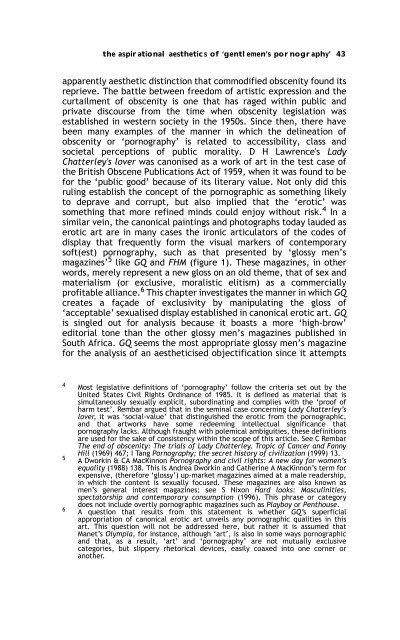Sex, Gender, Becoming - PULP
Sex, Gender, Becoming - PULP
Sex, Gender, Becoming - PULP
You also want an ePaper? Increase the reach of your titles
YUMPU automatically turns print PDFs into web optimized ePapers that Google loves.
the aspirational aesthetics of ‘gentlemen’s pornography’ 43<br />
apparently aesthetic distinction that commodified obscenity found its<br />
reprieve. The battle between freedom of artistic expression and the<br />
curtailment of obscenity is one that has raged within public and<br />
private discourse from the time when obscenity legislation was<br />
established in western society in the 1950s. Since then, there have<br />
been many examples of the manner in which the delineation of<br />
obscenity or ‘pornography’ is related to accessibility, class and<br />
societal perceptions of public morality. D H Lawrence's Lady<br />
Chatterley's lover was canonised as a work of art in the test case of<br />
the British Obscene Publications Act of 1959, when it was found to be<br />
for the ‘public good’ because of its literary value. Not only did this<br />
ruling establish the concept of the pornographic as something likely<br />
to deprave and corrupt, but also implied that the ‘erotic’ was<br />
something that more refined minds could enjoy without risk. 4 In a<br />
similar vein, the canonical paintings and photographs today lauded as<br />
erotic art are in many cases the ironic articulators of the codes of<br />
display that frequently form the visual markers of contemporary<br />
soft(est) pornography, such as that presented by ‘glossy men’s<br />
magazines’ 5 like GQ and FHM (figure 1). These magazines, in other<br />
words, merely represent a new gloss on an old theme, that of sex and<br />
materialism (or exclusive, moralistic elitism) as a commercially<br />
profitable alliance. 6 This chapter investigates the manner in which GQ<br />
creates a façade of exclusivity by manipulating the gloss of<br />
‘acceptable’ sexualised display established in canonical erotic art. GQ<br />
is singled out for analysis because it boasts a more ‘high-brow’<br />
editorial tone than the other glossy men’s magazines published in<br />
South Africa. GQ seems the most appropriate glossy men’s magazine<br />
for the analysis of an aestheticised objectification since it attempts<br />
4 Most legislative definitions of ‘pornography’ follow the criteria set out by the<br />
United States Civil Rights Ordinance of 1985. It is defined as material that is<br />
simultaneously sexually explicit, subordinating and complies with the ‘proof of<br />
harm test’. Rembar argued that in the seminal case concerning Lady Chatterley’s<br />
lover, it was ‘social-value’ that distinguished the erotic from the pornographic,<br />
and that artworks have some redeeming intellectual significance that<br />
pornography lacks. Although fraught with polemical ambiguities, these definitions<br />
are used for the sake of consistency within the scope of this article. See C Rembar<br />
The end of obscenity: The trials of Lady Chatterley, Tropic of Cancer and Fanny<br />
Hill (1969) 467; I Tang Pornography; the secret history of civilization (1999) 13.<br />
5<br />
A Dworkin & CA MacKinnon Pornography and civil rights: A new day for women’s<br />
equality (1988) 138. This is Andrea Dworkin and Catherine A MacKinnon’s term for<br />
expensive, (therefore ‘glossy’) up-market magazines aimed at a male readership,<br />
in which the content is sexually focused. These magazines are also known as<br />
men’s general interest magazines; see S Nixon Hard looks: Masculinities,<br />
spectatorship and contemporary consumption (1996). This phrase or category<br />
does not include overtly pornographic magazines such as Playboy or Penthouse.<br />
6 A question that results from this statement is whether GQ’s superficial<br />
appropriation of canonical erotic art unveils any pornographic qualities in this<br />
art. This question will not be addressed here, but rather it is assumed that<br />
Manet’s Olympia, for instance, although ‘art’, is also in some ways pornographic<br />
and that, as a result, ‘art’ and ‘pornography’ are not mutually exclusive<br />
categories, but slippery rhetorical devices, easily coaxed into one corner or<br />
another.
















